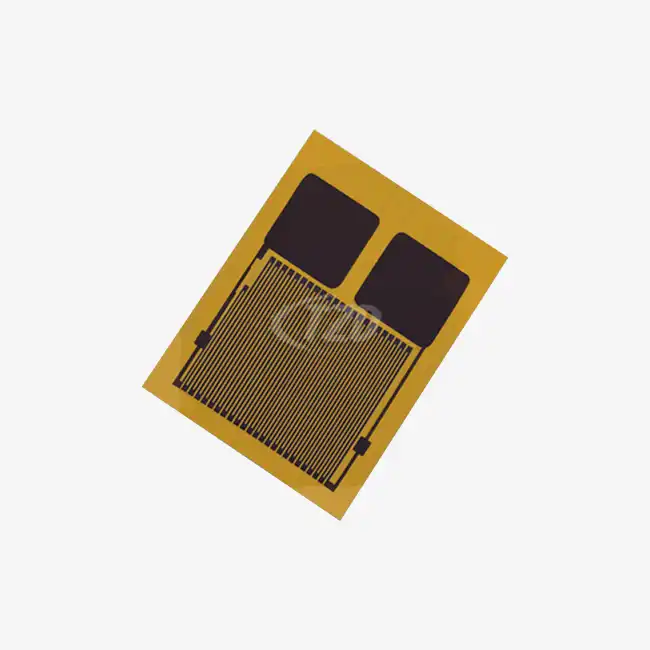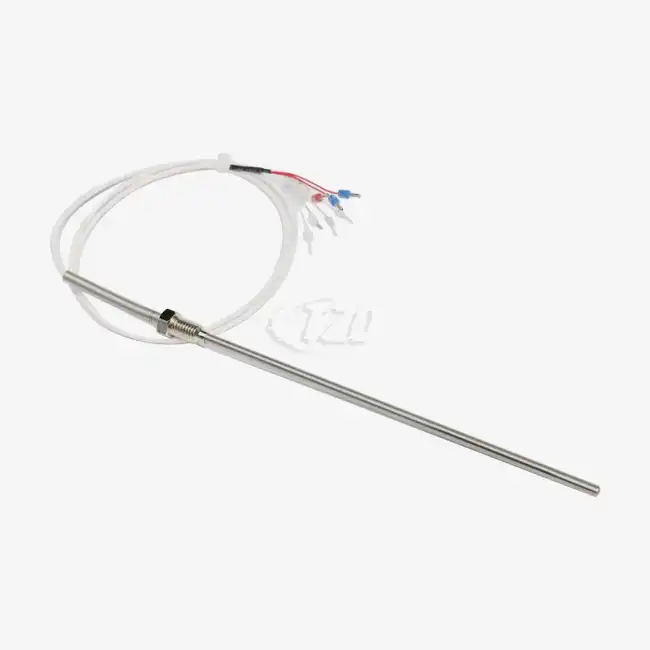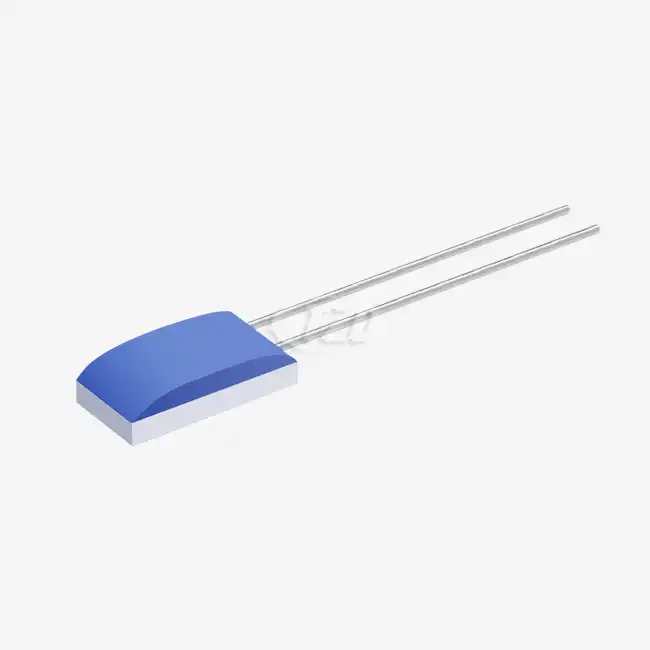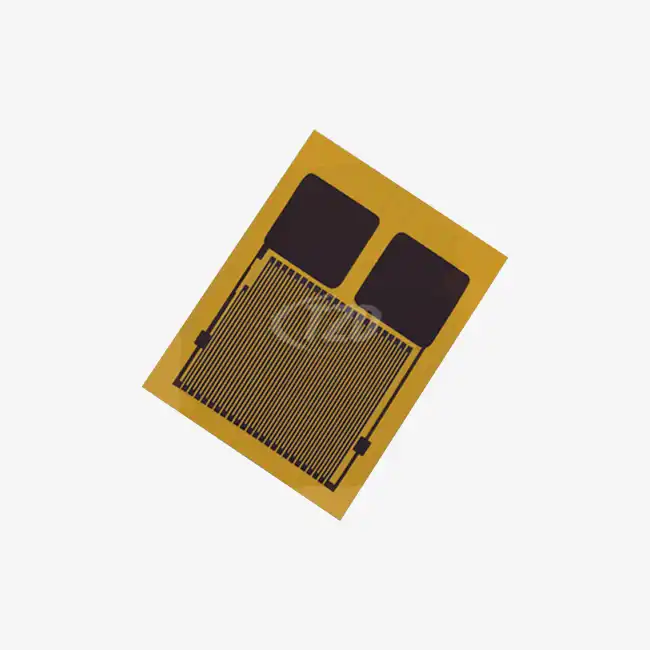The Unique Properties of Flexible Thin Film Temperature Sensors
Design and Construction
Flexible Thin Film Temperature Sensors represent a pinnacle of modern sensor technology, combining precision with adaptability. These sensors are crafted using advanced thin-film deposition techniques, resulting in an incredibly slim profile—often as thin as 0.05mm. This ultra-thin design is crucial for applications where space is at a premium or where the sensor must conform to curved surfaces.
The construction typically involves depositing a thin layer of temperature-sensitive material, such as platinum, onto a flexible substrate. This process creates a sensor that can bend and flex without compromising its performance. The flexibility is not just a physical attribute; it translates into versatility in application, allowing these sensors to be integrated into complex geometries and tight spaces that traditional rigid sensors cannot access.
Material Composition
The choice of materials in Flexible Thin Film Temperature Sensors is critical to their performance. Platinum is often the preferred material for the sensing element due to its exceptional stability and linear response to temperature changes. The use of platinum also contributes to the sensor's wide temperature range, typically spanning from -70°C to +200°C, with some high-performance models capable of measuring temperatures up to 850°C.
The substrate material is equally important, chosen for its flexibility, thermal stability, and compatibility with the sensing element. Common substrate materials include polyimide films, which offer excellent thermal and electrical insulation properties. The combination of these carefully selected materials results in sensors with a temperature coefficient of resistance (TCR) around 3850 ppm/°C, ensuring high sensitivity and accuracy in temperature measurements.
Customization and Versatility
One of the standout features of Flexible Thin Film Temperature Sensors is their customizability. Manufacturers offer these sensors in various dimensions, typically ranging from 1.2mm to 4.0mm, with the ability to customize sizes to meet specific application requirements. This flexibility extends to the choice of lead materials, with options including platinum nickel, silver nickel, or pure platinum, each offering different benefits in terms of conductivity and durability.
The versatility of these sensors is further enhanced by their rapid response time, often as quick as 0.05 seconds. This fast response is crucial in dynamic environments where temperature changes need to be detected and acted upon swiftly. Additionally, their robustness is demonstrated by their ability to withstand vibrations of up to 40g and impacts of up to 100g, making them suitable for use in harsh industrial environments, automotive applications, and even aerospace.

Performance in Vacuum Environments
Vacuum Compatibility
The compatibility of Flexible Thin Film Temperature Sensors with vacuum environments is a testament to their sophisticated design and material selection. In vacuum conditions, outgassing—the release of gas trapped in materials—can be a significant concern. However, the materials used in high-quality thin film sensors, particularly those with platinum sensing elements, exhibit minimal outgassing. This characteristic is crucial for maintaining the integrity of the vacuum and ensuring accurate temperature readings.
The thin profile of these sensors also contributes to their vacuum compatibility. With thicknesses as low as 0.05mm, they present minimal surface area and volume, reducing the potential for gas trapping and release. This slim design allows for easier integration into vacuum systems without compromising the seal integrity, a critical factor in maintaining vacuum conditions.
Stability and Accuracy
In vacuum environments, the stability of measurement devices becomes paramount. Flexible Thin Film Temperature Sensors excel in this regard, maintaining their accuracy across a wide range of pressures. The platinum sensing element, known for its stability, ensures consistent performance even in the absence of atmospheric pressure. This stability is reflected in the sensors' impressive accuracy, with some models achieving precision of ±0.01 Ω and long-term stability drift of ≤ 0.04%.
The accuracy of these sensors is further enhanced by their compliance with international standards such as IEC60751. This compliance ensures that the sensors meet rigorous performance criteria, providing reliable temperature measurements in vacuum conditions. The combination of material stability and adherence to standards results in sensors that can deliver consistent, accurate readings in vacuum environments ranging from low vacuum to ultra-high vacuum conditions.
Temperature Range and Response Time
Vacuum environments often present extreme temperature conditions, and Flexible Thin Film Temperature Sensors are well-equipped to handle these challenges. With a typical temperature range of -70°C to +200°C, and some models capable of measuring up to 850°C, these sensors can operate effectively in a wide array of vacuum applications, from cryogenic processes to high-temperature vacuum furnaces.
The rapid response time of these sensors, as fast as 0.05 seconds, is particularly advantageous in vacuum environments where temperature changes can occur swiftly. This quick response allows for real-time monitoring and control, critical in processes such as vacuum deposition, space simulation chambers, or vacuum thermal testing. The combination of wide temperature range and fast response time makes these sensors invaluable in vacuum-based research and industrial applications.

Applications and Industry Impact
Aerospace and Space Technology
In the realm of aerospace and space technology, Flexible Thin Film Temperature Sensors play a crucial role. Their compatibility with vacuum environments makes them ideal for use in spacecraft, satellites, and space simulation chambers. These sensors can accurately monitor temperatures in the extreme conditions of space, where vacuum and temperature fluctuations are constant challenges. Their ability to withstand vibrations of up to 40g and impacts of up to 100g ensures reliability during launch and in-orbit operations.
Space agencies and aerospace companies utilize these sensors in various applications, from thermal control systems in satellites to temperature monitoring in vacuum chambers simulating space environments. The sensors' thin profile and flexibility allow for integration into complex spacecraft structures without adding significant weight or bulk, a critical factor in space technology where every gram counts.
Semiconductor Manufacturing
The semiconductor industry heavily relies on vacuum processes, and Flexible Thin Film Temperature Sensors are integral to these operations. In processes such as physical vapor deposition (PVD), chemical vapor deposition (CVD), and ion implantation, precise temperature control in vacuum environments is essential for ensuring product quality and process efficiency.
These sensors are used to monitor substrate temperatures during deposition processes, ensuring uniform film growth and preventing overheating. Their fast response time allows for real-time adjustments to maintain optimal process conditions. The sensors' ability to conform to curved surfaces is particularly valuable in monitoring temperature across silicon wafers, ensuring uniformity in semiconductor production.
Research and Development
In scientific research, particularly in fields involving vacuum technology, Flexible Thin Film Temperature Sensors are indispensable tools. They are used in a wide range of research applications, from studying material properties under vacuum to developing new vacuum-based manufacturing processes. The sensors' high accuracy and stability make them suitable for precise experiments in physics, materials science, and chemistry.
Research institutions and laboratories utilize these sensors in vacuum furnaces, cryogenic systems, and ultra-high vacuum chambers. Their compatibility with extreme temperatures and pressures allows researchers to explore phenomena that occur only in vacuum conditions, contributing to advancements in fields such as quantum physics, surface science, and space exploration technology.
Conclusion
Flexible Thin Film Temperature Sensors have proven to be exceptionally compatible with vacuum environments, offering a unique combination of accuracy, flexibility, and reliability. Their ability to perform in extreme conditions, coupled with their customizable nature, makes them an invaluable asset across various industries and research fields. As technology continues to advance, these sensors will likely play an increasingly crucial role in pushing the boundaries of what's possible in vacuum-based applications.
For those seeking to leverage the capabilities of Flexible Thin Film Temperature Sensors in vacuum environments or other challenging applications, Xi'an Tongzida Technology Co., Ltd. offers state-of-the-art solutions. With our expertise in sensor manufacturing and commitment to quality, we provide sensors that meet the highest standards of performance and reliability. To learn more about our offerings or to discuss your specific needs, please contact us at sales11@xatzd.com.




